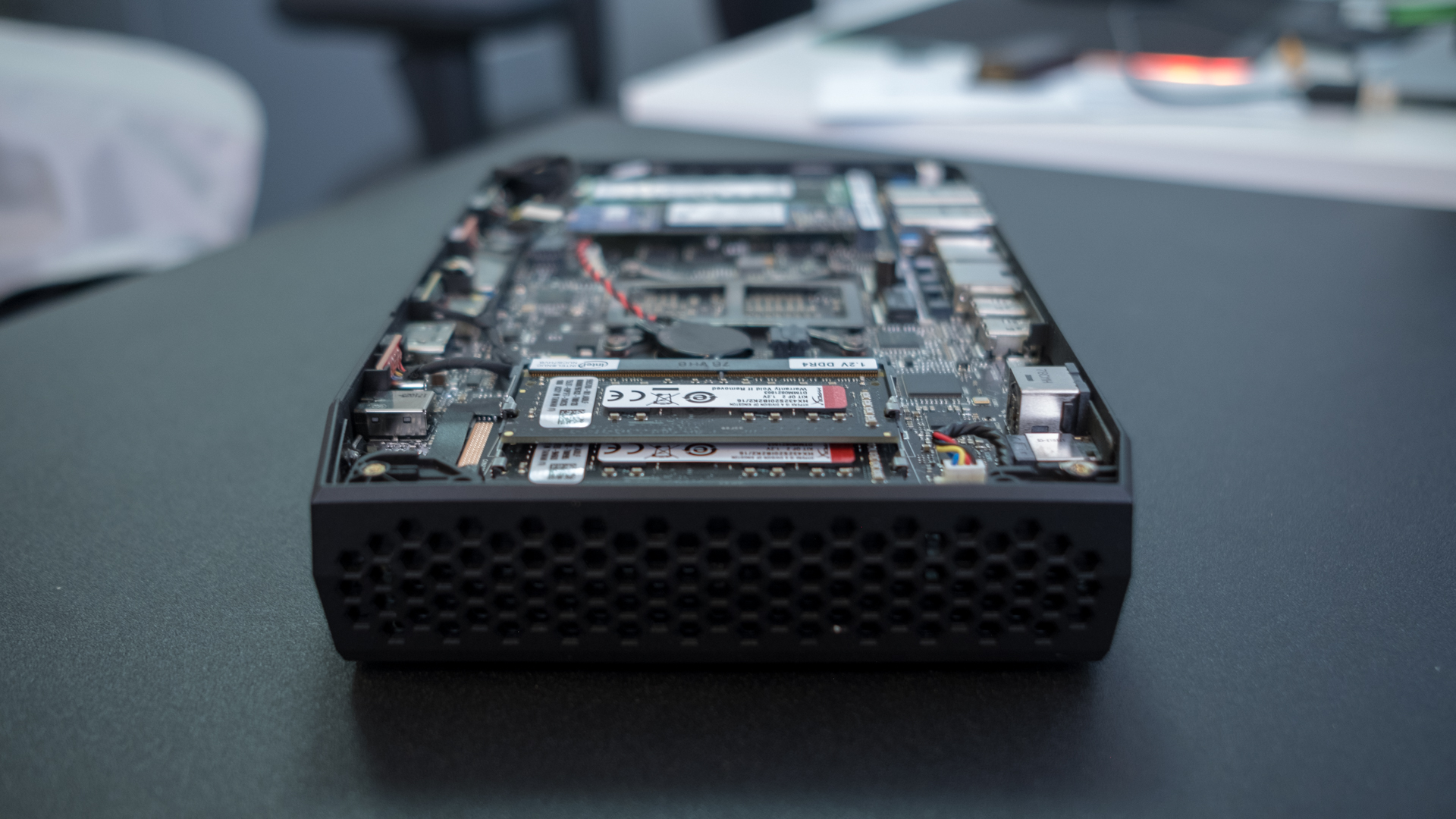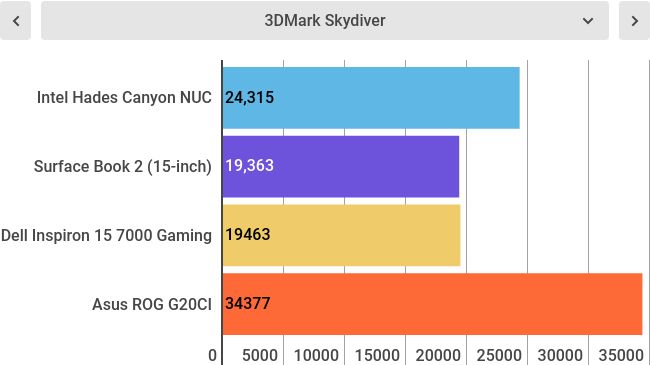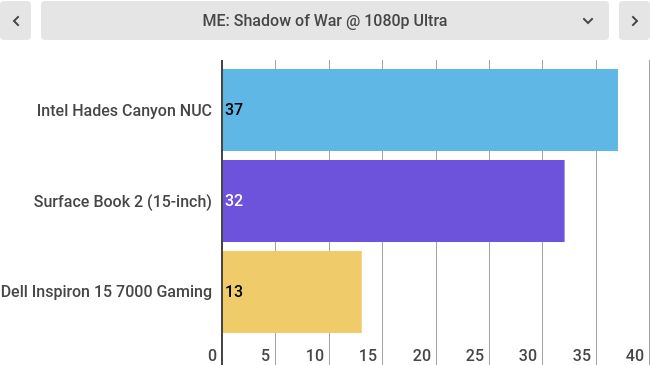TechRadar Verdict
The Intel Hades Canyon NUC delivers true high-end desktop computing on a single chip packed into an impressively small and well-equipped mini PC.
Pros
- +
High-end desktop computing on a single chip
- +
Expansive array of ports
- +
Easily upgradable
Cons
- -
Expensive without everything included
- -
Maximum 4GB of video memory
Why you can trust TechRadar
Intel’s ‘Next Unit of Computing’ hardware platform has always showcased some of the chipmakers most interesting silicon concepts. This year, the Hades Canyon NUC represents a partnership between Intel and AMD we would have never expected – or even fathomed.
It’s easily the smallest VR-capable PC that marries together an Intel quad-core processor with integrated, ‘discrete-class’ AMD Radeon RX Vega graphics into a single chip. With all that power under its belt, this gaming PC easily smashes through Full HD gaming with most modern titles and performs like a productivity champ.
Despite all the caveats of that comes with a barebones computer such as this, the Intel Hades Canyon NUC earns top marks for packing so much performance into a small package. It’s one of the best and our favorite mini PC of the year so far.

Here is the Intel Hades Canyon NUC configuration sent to TechRadar for review:
CPU: 3.1GHz Intel Core i7-8809G (quad-core, 8MB Cache, up to 4.2GHz)
Graphics: Radeon RX Vega M GH graphics (4GB HBM2 VRAM), Intel UHD Graphics 630
RAM: Kingston HyperX 16GB DDR4 (3,200MHz)
Storage: 118GB Intel Optane SSD 800P Series (NVMe), 512GB Intel SSD 545s Series (M.2 SATA)
Ports (front): 1 x USB-C 3.1 Gen 2, 1 x USB-A 3.1 Gen 2, 1 x USB-A 3.1 Gen 1, SD card reader, HDMI 2.0a
Ports (rear): 2 x Thunderbolt 3 (USB-C), 4 x USB 3.0, HDMI 2.0a, 2 x mini DisplayPort, 2 x Ethernet, optical audio out
Connectivity: Intel Wireless-AC 8265, Bluetooth 4.2
Weight: 2 pounds (0.91kg)
Size: 8.7 x 5.6 x 1.54 inches (22.1 x 14.2 x 3.9cm; W x D x H)
Price and availability
Our particular Intel Hades Canyon NUC8i7HVK review unit costs $999 (about £710, AU$1,302), which is about half-to-a-third off the price of an equally competent gaming laptop. Not too shabby for a PC equipped with a quad-core Intel Core i7 and nearly Nvidia GTX 1060 equivalent graphics.
That said, this barebones unit doesn’t come with storage, memory or an operating system, so you’ll have to get those pieces on your own.
There’s also an entry-level Intel Hades Canyon NUC8i7HNK priced at $799 (about £570, AU$1,040). This more affordable NUC comes still comes with a quad-core i7 CPU, but it maxes out at a slower frequency. Meanwhile, the onboard Radeon RX Vega M GL GPU has four fewer compute units and won’t run as fast either.
Compared to other barebone PCs, the high-end Intel Hades Canyon NUC compares well against the $949 (£619, AU$1,739) Zotac Zbox Magnus EN1060K and $999 (£819, AU$1,579) Gigabyte Brix GB-BNi7HG6-1060. Both of these mini PCs feature older Kaby Lake processors but a Nvidia GTX 1060 with two more GB of video RAM and higher CUDA
Sign up for breaking news, reviews, opinion, top tech deals, and more.






Design
At first blush, the Hades Canyon NUC looks more like a set top box than a desktop PC, and that’s honestly a good thing. The device is interesting enough to look like more than just a plain box in your home entertainment setup while also not being too distracting if you decide to use it as your work computer.
If you remember the Skull Canyon NUC Intel released two years prior, the Hades Canyon should look very familiar. Both units share the same overall shape, plus an identical hexagonal motif for the ventilation holes and top panel. Of course, with the integration of ‘discrete-class’ graphics and sufficient cooling to back it up, Intel’s flagship NUC is almost twice as large as its predecessor.
Intel’s design has also seen some improvements. The old interchangeable plastic panels have been replaced by a much slicker light-up skull fashioned after the silicon that resides within. The lighting on this part of the case and all the little hard drive and power indicators are fully customizable – or you could just turn them all off for a stealthy unit.
Despite this PC’s small size, it packs an impressive amount of ports. Along the backside alone you’ll find four USB 3.0 ports, two ThunderBolt 3 ports, two mini DisplayPorts, HDMI 2.0 and even two Gigabit Ethernet ports. That’s more connectivity than you’ll even find on some full-size desktops.
Cracking open the Hades Canyon NUC is a breeze, as it just requires undoing six torx screws and a single Philips head. With the top cover removed, you can access the computer’s memory slots as well as the M.2 NVMe and SATA drives.












Here’s how the Intel Hades Canyon NUC performed in our suite of benchmark tests:
3DMark: Sky Diver: 24,315; Fire Strike: 8,525; Time Spy: 3,102
Cinebench CPU: 851 points; Graphics: 151 fps
GeekBench: 5,152 (single-core); 17,191 (multi-core)
PCMark 8 (Home Test): 4,276 points
Total War: Warhammer II (1080p, Ultra): 28 fps; (1080p, Low): 60 fps
ME: Shadow of War (1080p, Ultra): 37 fps; (1080p, Low): 89 fps
Performance
The ‘discrete-class’ Radeon RX Vega graphics are every bit as impressive as Intel and AMD promised. We can play all our favorite games, including Far Cry 5 and Warhammer: Vermintide 2, at a steady 60 frames per second (fps) with high-quality graphical settings and a 1080p resolution.
Even more impressive is that the little PC holds it own through Overwatch and Hitman at 1440p with HDR active on a Samsung CHG70 QLED gaming monitor. The only title to give us some measurable difficulty is Assassin’s Creed Origins, but it still runs at a completely playable 40fps with high quality settings and a 1080p resolution.
Outside of gaming, the Intel Hades Canyon NUC runs like a champ through all our regular web browsing and word processing, as well as our image and video editing needs. For those multi-monitor fans, the Intel Hades Canyon NUC can also drive up to six screens.
Compared to comparable notebook hardware in the 15-inch Microsoft Surface Book 2, the Intel NUC almost wins the complete race in both processor and graphically intensive tests. A full-on gaming laptop like the Dell Inspiron 15 7000 Gaming manages to close the gap a little better, but for the most part the Hades Canyon stays on top.
Meanwhile, a gaming PC with actual desktop parts, like the Asus ROG G20CI, proves to be tougher competition. While the NUC manages to score better in the processor tests, the integrated graphics just can’t keep up with a Nvidia GTX 1080 – then again, neither could the AMD Radeon RX Vega 64.

Final verdict
The Intel Hades Canyon NUC is the company’s most impressive mini PC yet, capable of playing most modern games with ease and offering plenty of performance for everyday computing. And, that’s all without the help of an external GPU, unlike the previous Skull Canyon NUC.
This is true high-end desktop computing on a single, standalone chip. Beyond this one device, it represents a turning point for thin-and-light laptops like HP Spectre x360 15 and Dell XPS 15 2-in-1 to be just as powerful as full-on gaming laptops
Although the Hades Canyon NUC might be expensive and require additional parts, you won’t find another mini PC as powerful as this. The expansive array of ports and support for high-end internal components is equally as amazing. Thanks to its small size, it's also the perfect home theater PC.
All in all, Intel has produced an incredibly tiny and VR-capable gaming PC worthy of your attention and consideration.

Kevin Lee was a former computing reporter at TechRadar. Kevin is now the SEO Updates Editor at IGN based in New York. He handles all of the best of tech buying guides while also dipping his hand in the entertainment and games evergreen content. Kevin has over eight years of experience in the tech and games publications with previous bylines at Polygon, PC World, and more. Outside of work, Kevin is major movie buff of cult and bad films. He also regularly plays flight & space sim and racing games. IRL he's a fan of archery, axe throwing, and board games.
